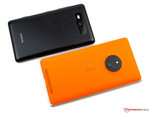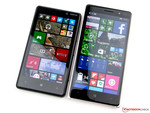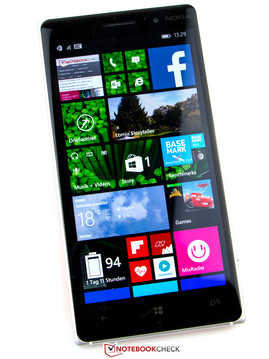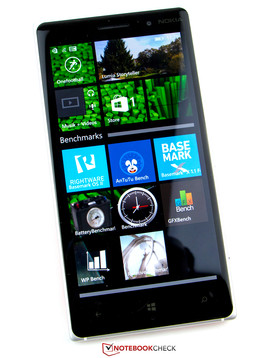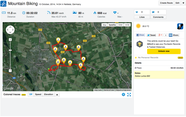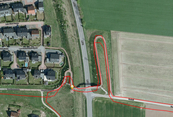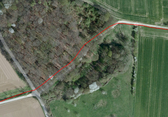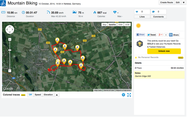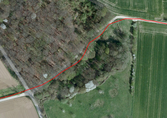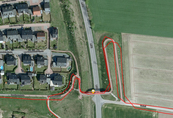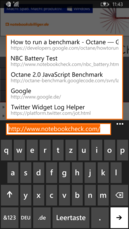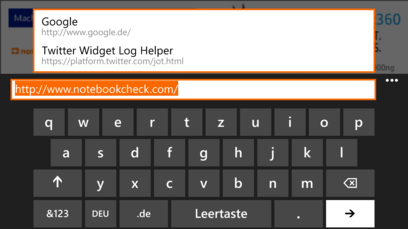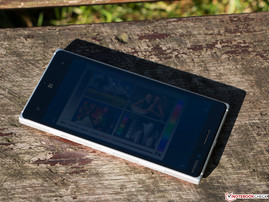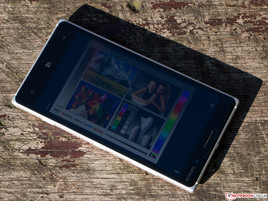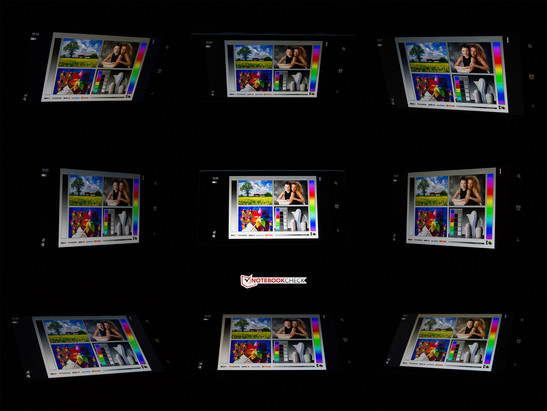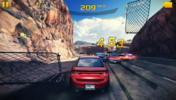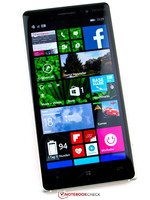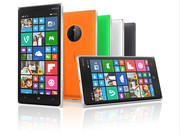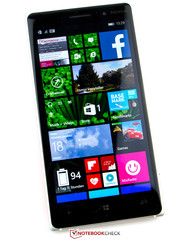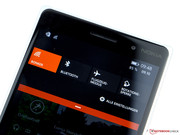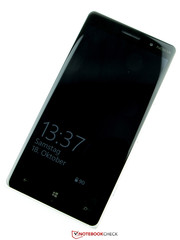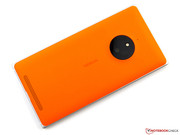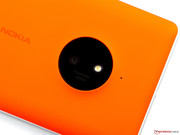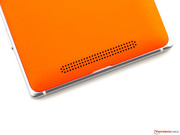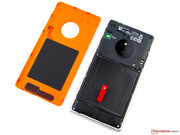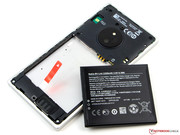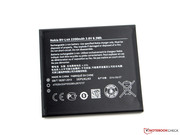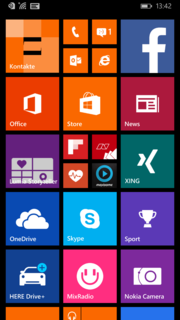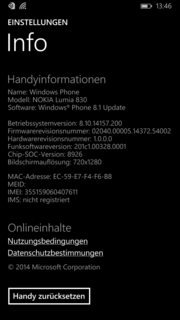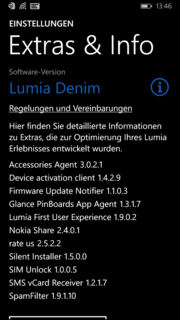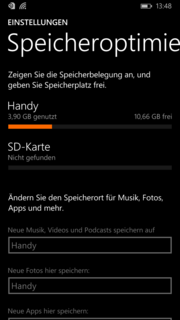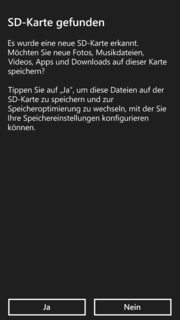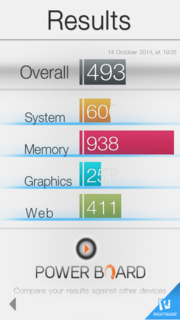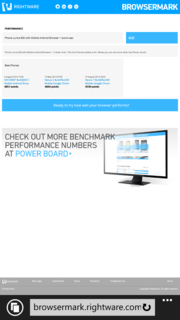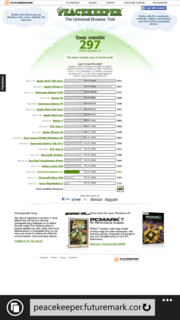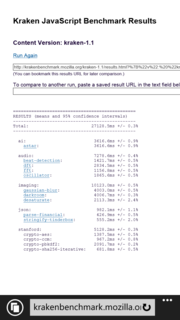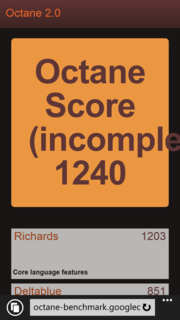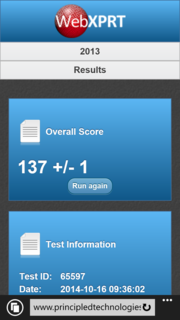Nokia Lumia 830 Smartphone Review

For the original German review, see here.
The Nokia Lumia 830 is the last smartphone that will bear the Finnish company's phone logo. Future models will be developed and sold under Microsoft's brand name. The manufacturer advertises the device as an affordable flagship smartphone with up-to-date Windows Phone 8.1 (update 1, Lumia Denim). The price of approximately 350 Euros (~$437) makes this sound quite justified, but doubts arise quickly when looking at the technical specifications. The weak quad-core processor from Qualcomm is found in many entry-level models, and the integrated Adreno 305 graphics unit belongs to the lower mid-range. Even looking at the screen, it becomes obvious that we are dealing with a mid-range smartphone. A 720p screen is fair enough, but not appropriate for a modern flagship phone. Nevertheless, the Lumia 830 makes both a quality and stable impression, almost like a small Lumia 930, with its aluminum bezel.
There are plenty of competitors equipped with Google's Android. The Lumia 830 faces Sony's Xperia M2 (starting at 190 Euros; ~$237) and T3 (starting at 290 Euros; ~$362), HTC's Desire 816, HTC's One Mini 2 (starting at 360 Euros; ~$450), and Huawei's Ascend P7 (starting at 290 Euros; ~$362). The latter two devices actually have a much higher RRP, but their prices have fallen.
Case
The aluminum bezel of Nokia's Lumia 830 is very robust, which makes the device feel heavy in the hand. It weights 150 grams (~5.3 ounces). With a thickness of 8.5 millimeters (~0.33 inches), it is not one of the slimmest. The screen is protected by scratch-resistant Corning Gorilla Glass 3.
The smartphone proved absolutely resistant to warping attempts, and did not produce the slightest noise. Even pressure barely affected the device. Only strong pressure on the display caused waves on the screen. Both the aluminum bezel and the display are slightly rounded, giving it a pleasant feel. The gaps are also beyond reproach; they are all even and not too wide.
Like the Lumia 820, the new edition also features an exchangeable polycarbonate back, available in the colors orange, green, white, and black. The induction point for wireless recharging is integrated into the back cover. Removing the back gives access to the replaceable battery, the nano slot, and micro-SD slot.
Connectivity
The micro-USB 2.0 port of Nokia's Lumia 830 is used for both recharging the smartphone, and sharing data with a computer. It does not support features like MHL or OTG.
Consequently, it is only possible to transmit images to an external device via a wireless connection. The most common standards DLNA and Miracast are available for this purpose. Additionally, a Secure NFC chip is integrated into the phone that not only allows connecting with authorized devices, but is also suitable for cash-less payments.
The micro-SD slot supports memory cards with a capacity of up to 128 GB. The slot gives an unusually high-quality impression, owing to its eject mechanism.
Software
Nokia's Lumia 830 is the first smartphone that is installed with the latest Microsoft Windows Phone 8.1 (update 1, Lumia Denim). The most important innovation is the incorporation of Microsoft's proprietary personal assistant "Cortana" that supposedly can be enabled from standby with "Hey Cortana!" Unfortunately we could not test this feature as it is currently only available in the United States. More languages and regions will be supported with update 2, which is to be released this year.
The "Glance" screen has been reworked even more, and can now display more information and widgets when the phone is in standby. In addition, the camera's start speed has been improved, but still it is not very fast. However the improvement is noticeable.
The user interface has not changed much. However, it is now possible to group apps, which has been consistently integrated into the tile look. The known application software "Here Drive+" (offline navigation), "Here Maps", and "Nokia MixRadio" are also preloaded, and still free of charge. This is also true for Microsoft Office 2013 Mobile that enables opening Word, Excel, and PowerPoint files easily.
Users who insert a micro-SD card, can decide where media, cards, and apps are to be stored or installed. It is also possible to easily move preloaded apps to the other storage, and to open them from there.
Communication & GPS
Nokia's Lumia 830 has a Wi-Fi module that supports the IEEE 802.11 a/b/g/n standards, and thus operates in both the 2.4 and 5.0 GHz frequency ranges. Although the component does not support the latest ac standard, its range is very good. The connection quality was still good, even at a distance of 20 meters (~65.6 ft) from the router (Fritz!Box 6360), and websites opened without any noticeable delays.
Users who want to connect to the Internet on the go, can draw on unlimited resources with the Lumia 830. It not only supports quad-band HSPA+ (max. 42 Mbps), but also high-speed LTE Cat. 4 that enables a downstream speed of up to 150 Mbps if the provider and the selected tariff plan support this. However, the latest Cat. 6 standard is not supported.
GPS and GLONASS are available to determine position. Satellites were found very quickly, and it only took slightly longer inside buildings. We compared its accuracy with the Garmin Edge 500 bike computer. Although the Lumia 830 displayed minor weaknesses on narrow trails or in difficult terrain, the difference is below one percent for the entire route. A great outcome.
Telephone & Voice Quality
The voice quality of Nokia's Lumia 830 is quite decent, although we noticed a background noise when the phone was held to the cheek. This was not the case when we made calls using the speaker. However, the output via the speaker was distorted, overdriven, and trebles sounded piercing. Background noise suppression functioned quite well, and thus telephony made an above average total impression.
The smartphone's phone app features a plain design. Nevertheless, it scores with some good features. For example, it is possible to store a manually dialed number just by pressing a button. In addition, the user can switch an active call to Skype, provided that the contact's device also supports this feature. Buyers also get three months free of charge for landline calls via Skype.
Cameras
The front-facing camera of Nokia's Lumia 830 has a low resolution of 0.9 megapixels, and is suitable for video conferencing. The quality is not sufficient for selfies in most cases. This is not a tragedy, since it is quite easy to shoot these pictures with the primary camera via the "Lumia Selfie" app.
The rear-facing lens has a resolution of 10 megapixels (3520x2640 pixels; 4:3), and an optical image stabilizer. Pictures shot in daylight are impressive, though they are slightly overexposed in brighter sections and the colors look a bit too saturated. The Lumia 830 struggles with similar problems in low light, but the colors look paler. The light sensitivity can be set up to ISO 3200, but a moderate noise might evolve. Also, details look quite muddy in this scenario. The LED flash provides good illumination and enables appealing results.
Microsoft has many apps in its portfolio that have been designed for different take scenarios. The camera can be used for panorama or live pictures. Nevertheless, the Lumia 830 does not belong to the devices that benefit from all the improvements of the Denim update. The device does not feature UHD video recording.
The smartphone records videos in Full HD (1920x1080 pixels; 16:9; 20 Mbps), and the user can choose from among 24, 25 and 30 fps. The quality is good, and the optical image stabilizer ensures steady hand-held recordings. The smartphone records sound in Dolby Digital 5.1 Plus, which functioned quite well. The surround sound is very audible. The audio quality is also relatively good.
Accessories
The accessories included with Nokia's Lumia 830 are comparatively meager. They consist of a USB data cable, a printed quick guide, and a modular power supply with an output of 7.5 Watts (5 volts; 1.5 ampere). The manufacturer does not add a headset.
Microsoft is quite generous with optional accessories and offers a range of headsets, wireless speakers, and chargers, as well as Miracast receivers for image transmission.
Warranty
Microsoft Mobile includes a 24-month warranty on the Lumia 830 that cannot be extended.
Input Devices & Controls
The capacitive touchscreen of Nokia's Lumia 830 is protected by Corning Gorilla Glass 3 and features good gliding properties. Inputs are implemented quickly and accurately, and there are no delays even in the screen's corners. Double tapping awakens the screen from standby. This is a familiar feature from older Lumias and could be further developed. A good example would be LG's KnockCode. The touchscreen can also still be used well with thick leather gloves.
The keyboard layout of Windows Phone 8.1 has not changed much. Users who write messages will be pleased with the automatic word suggestion. Otherwise, the layout is very practical and does not offer many special functions. Space is wasted in landscape mode because the sides are simply left blank.
The sensor buttons below the screen respond nicely and very reliably. They have a backlight, which makes them easy to see in the dark. The device confirms inputs with a subtle, palpable vibration.
We could not test the personal assistant Cortana because so far the full version is only available in the United States. Other English-language regions are in the test phase. This also applies to China.
Display
The 5-inch screen of Nokia's Lumia 830 has a resolution of 1280x720 pixels. This corresponds to an aspect ratio of 16:9 and pixel density of 294 ppi. A Full HD screen would certainly have been more appropriate in view of the price, but the available resolution is absolutely sufficient for the screen's diagonal.
The IPS screen's maximum brightness of 449 cd/m² is very good, but most competitors exceed it. The brightest screen in the comparison field is found in the Xperia T3 (max. 532 cd/m²; 89%). The review sample's illumination of 87% is within a decent range, though all competitors are better here. However, subjectively, there is no reason for complaint; we did not even observe any visible clouding.
| |||||||||||||||||||||||||
Brightness Distribution: 87 %
Center on Battery: 440 cd/m²
Contrast: 571:1 (Black: 0.77 cd/m²)
ΔE ColorChecker Calman: 2.6 | ∀{0.5-29.43 Ø4.79}
ΔE Greyscale Calman: 2.64 | ∀{0.09-98 Ø5}
Gamma: 2.32
CCT: 6686 K
| Nokia Lumia 830 Adreno 305, 400 MSM8926, 16 GB eMMC Flash | Asus Zenfone 5 Adreno 305, 400 MSM8926, 8 GB eMMC Flash | Sony Xperia T3 Adreno 305, 400 MSM8928, 8 GB SSD | HTC One Mini 2 Adreno 305, 400 MSM8226, 16 GB iNAND Flash | Huawei Ascend P7 Mali-450 MP4, Kirin 910T, 16 GB eMMC Flash | |
|---|---|---|---|---|---|
| Screen | -8% | -31% | -35% | -16% | |
| Brightness middle (cd/m²) | 440 | 389 -12% | 521 18% | 444 1% | 464 5% |
| Brightness (cd/m²) | 421 | 375 -11% | 504 20% | 439 4% | 470 12% |
| Brightness Distribution (%) | 87 | 88 1% | 89 2% | 94 8% | 92 6% |
| Black Level * (cd/m²) | 0.77 | 0.58 25% | 0.77 -0% | 0.57 26% | 0.92 -19% |
| Contrast (:1) | 571 | 671 18% | 677 19% | 779 36% | 504 -12% |
| Colorchecker dE 2000 * | 2.6 | 4.22 -62% | 5.73 -120% | 6.59 -153% | 4.18 -61% |
| Greyscale dE 2000 * | 2.64 | 3.08 -17% | 6.83 -159% | 7.14 -170% | 3.71 -41% |
| Gamma | 2.32 95% | 2.57 86% | 3.46 64% | 2.48 89% | 2.48 89% |
| CCT | 6686 97% | 6840 95% | 8370 78% | 8636 75% | 6441 101% |
* ... smaller is better
The Lumia 830's black level of 0.77 cd/m² is slightly high. HTC's One Mini 2 (0.57 cd/m²; 779:1) exhibits a considerably more balanced ratio, and provides a better black value at a similar brightness. The review sample's black does not look saturated, but more like charcoal black. This also leads to a rather average contrast ratio of 571:1.
On the other hand, the Lumia 830's color reproduction is very good. The colors are rendered naturally, and shifts are not visible. All results remain below a deltaE rate of 4, and there are no spikes.
Nokia's Lumia 830 performs well outdoors. The reflections on the screen are sometimes distracting, but only when looking at it from the sides. The average contrast ratio is more noticeable in sunlight, but the content remains clearly visible. The review sample is impeccable indoors or in the shade.
Nokia's Lumia 830 uses an IPS screen, which is actually a symbol for high viewing angle stability. This is also largely true for the review sample. The viewing angles remain stable both horizontally and vertically, and only struggle with a minor loss of brightness. However, an intense IPS glow is noticed when looking diagonally over the screen from an angle of approximately 60 degrees. This applies particularly to dark screen areas. The effect is unsightly, and also visible when the smartphone is on a table.
Performance
The performance is the biggest problem of Nokia's Lumia 830 and kills any ambitions of being a flagship smartphone. The installed Qualcomm Snapdragon 400 MSM8926 has four cores that clock with 1.2 GHz each, supported by 1 GB of working memory. The integrated Adreno 305 is already outdated.
As a result, the Lumia 830 scores badly in the benchmarks, although most competitors are based on the same SoC. Unfortunately, there are not many cross-platform benchmarks for Windows Phone 8.1, and Basemark X 1.1 did not even want to start. To illustrate the performance difference between the review sample and a high-end phone, we added the Lumia 930 (Snapdragon 800) and Galaxy Note 4 (Snapdragon 805) to the comparison devices.
The latter devices present clear speed advantages in all sectors. The CPU in the Note 4 is six times faster in Linpack, and the Adreno 420 from the Korean manufacturer is even ten times faster than the corresponding components in the Lumia 830. Microsoft also uses the SoC in its entry-level models that simply have a lower working memory capacity. However, the Lumia is also slower than Android devices based on the same SoC. This is not noticeable in practice; Windows Phone 8.1 runs smoothly and without lags.
Browsing on the Internet also functions very well with Internet Explorer 11, although it is noticeable that page setups are sometimes rather slow. The device scores moderately in the benchmarks here. The comparison with the stronger Lumia 930 proves that IE 11 can be much faster when the appropriate hardware is installed.
The Lumia 830 has a storage capacity of 16 GB, of which 10.66 "real" GB are free. If that is not enough, the storage can be expanded by up to 128 GB via a micro-SD card. The storage speed is really good, and even beats the Note 4 in Basemark OS II.
| GFXBench (DX / GLBenchmark) 2.7 | |
| T-Rex Onscreen (sort by value) | |
| Nokia Lumia 830 | |
| Sony Xperia M2 | |
| HTC One Mini 2 | |
| Asus Zenfone 6 | |
| Huawei Ascend P7 | |
| Nokia Lumia 930 | |
| Samsung Galaxy Note 4 | |
| 1920x1080 T-Rex Offscreen (sort by value) | |
| Nokia Lumia 830 | |
| Sony Xperia M2 | |
| HTC One Mini 2 | |
| Asus Zenfone 6 | |
| Huawei Ascend P7 | |
| Nokia Lumia 930 | |
| Samsung Galaxy Note 4 | |
| Peacekeeper - --- (sort by value) | |
| Nokia Lumia 830 | |
| Sony Xperia T3 | |
| Sony Xperia M2 | |
| HTC One Mini 2 | |
| Huawei Ascend P7 | |
| Nokia Lumia 930 | |
| Samsung Galaxy Note 4 | |
| Sunspider - 1.0 Total Score (sort by value) | |
| Nokia Lumia 830 | |
| Sony Xperia T3 | |
| Sony Xperia M2 | |
| HTC One Mini 2 | |
| Asus Zenfone 6 | |
| Huawei Ascend P7 | |
| Nokia Lumia 930 | |
| Samsung Galaxy Note 4 | |
| Octane V1 - Total Score (sort by value) | |
| Nokia Lumia 830 | |
| Sony Xperia T3 | |
| Sony Xperia M2 | |
| Samsung Galaxy Note 4 | |
* ... smaller is better
Games
The Qualcomm Adreno 305 no longer belongs to the high-performance graphics units. Nevertheless, Microsoft manages to tease out a lot of power from the GPU. For example, more details are visible in games like Asphalt 8 than in comparable Android versions that use the same GPU. Most tracks run without any problems, but the load speed makes it obvious that the SoC is not the fastest. Some games even display minor stutters, such as the race game Cars.
The sensors function extremely well, making a positive impact, especially in race games because the control responds to the slightest tilt.
Emissions
Temperature
The surface temperatures of Nokia's Lumia 830 reached a maximum of 31.2 °C (~88.16 °F) while idling. We simulated load with the Relative Benchmark app that ran for over one hour before we measured the temperature. The review sample reached up to 36.9 °C (~98.42 °F) on the back, and the front was even slightly cooler.
This represents a good outcome in the comparison field, which we also expected in view of the weak SoC. Only the Xperia T3 steps out of line slightly with temperatures of up to 46 °C (~114.8 °F).
(+) The maximum temperature on the upper side is 34.8 °C / 95 F, compared to the average of 35.2 °C / 95 F, ranging from 21.9 to 247 °C for the class Smartphone.
(+) The bottom heats up to a maximum of 36.8 °C / 98 F, compared to the average of 34 °C / 93 F
(+) In idle usage, the average temperature for the upper side is 29.4 °C / 85 F, compared to the device average of 32.9 °C / 91 F.
Speakers
The rear-sided speaker can get really loud, but only produces a mediocre sound quality. Users who are satisfied with half the level, can enjoy a satisfactory sound experience. Beyond that, the sound distorts and a crackling noise is heard from the speaker at irregular intervals. The trebles overdrive extremely, and sometimes sound piercing. Although the smartphone vibrates at maximum volume, it is not in any way related to bass. Users who want to listen to music with the Lumia 830, should use an external speaker or the audio jack. The latter does not give reason for complaint.
Energy Management
Power Consumption
Nokia's Lumia 830 does everything right in terms of power consumption. The idle requirement ranges from 0.5 to 1.7 Watts. The former Lumia 820 (1.5 - 3.2 Watts) consumed considerably more.
The smartphone's power consumption climbs up to 3.6 Watts under load. This is no reason for complaint either. Other devices have a higher requirement here. HTC's One Mini 2 (max. 4.5 Watts; 4.5 inches) has a higher consumption, despite a similar SoC and smaller screen. Only the Zenfone 5 (max. 3.1 Watts; 5 inches) does a better job in the comparison field.
| Off / Standby | |
| Idle | |
| Load |
|
Key:
min: | |
Battery Runtime
The removable battery in Nokia's Lumia 830 has a capacity of 2200 mAh, and allows the smartphone to reach really good runtimes. Some rates have even clearly improved compared with the Lumia 820. Only the full load runtime could be slightly longer, but that has increased by a whole 50% compared to its precursor.
A good comparison basis of the runtimes is achieved in the tests using an adapted brightness (150 cd/m²). All power consumers except for Wi-Fi are disabled in the Wi-Fi browsing test. A script that opens a new website every 40 seconds in the browser is executed. The review sample achieved a good time with over twelve hours, which none of the other competitors in the comparison field reached.
| Nokia Lumia 830 Adreno 305, 400 MSM8926, 16 GB eMMC Flash | Nokia Lumia 820 Adreno 225, S4 Plus MSM8960, 8 GB SSD | Asus Zenfone 5 Adreno 305, 400 MSM8926, 8 GB eMMC Flash | Sony Xperia T3 Adreno 305, 400 MSM8928, 8 GB SSD | HTC One Mini 2 Adreno 305, 400 MSM8226, 16 GB iNAND Flash | Huawei Ascend P7 Mali-450 MP4, Kirin 910T, 16 GB eMMC Flash | |
|---|---|---|---|---|---|---|
| Battery runtime | -24% | -10% | -26% | -24% | -12% | |
| Reader / Idle (h) | 30.1 | 18.5 -39% | 18.9 -37% | 19.5 -35% | 20.8 -31% | 16.1 -47% |
| H.264 (h) | 9.6 | 8.5 -11% | ||||
| WiFi (h) | 12 | 12 0% | 9.1 -24% | 10.6 -12% | 9.1 -24% | 9.6 -20% |
| Load (h) | 2.9 | 1.9 -34% | 3.8 31% | 2 -31% | 2.1 -28% | 3.8 31% |
Verdict
Nokia's Lumia 830 sets sail under the old flag one last time. The design strongly resembles that of the Lumia 930, and pleases with high-quality materials and an excellent build. This impression stretches over every detail. For example, both the SIM and micro-SD slot feature an eject mechanism, although they are not integrated into the frame. We have never seen anything like this before. The phone really feels like a flagship device when held in the hand.
However, compromises are found in the details. The screen actually made a decent impression, and is satisfactory with its pleasing brightness and outstanding color reproduction. But the intense IPS glow in flat viewing angles was sometimes annoying, and the increased black level ruined the impression a little. The weak SoC is currently adequate, but what that will look like after the next major update of Windows Phone is difficult to forecast. In addition, the installed speaker is simply inferior.
However, Microsoft has done many things right with the Lumia 830. The 16 GB storage is comparatively generous since 8 GB is still standard for mid-range smartphones. It can also be expanded by up to 128 GB - this is rare in this price range. The camera also made a good impression, and copes well, even in more difficult light conditions. The GPS receiver is also satisfactory with its decent performance.
The biggest point of criticism remains to be the price. Microsoft corrected it from its initial 399 to 349 Euros (~$498 to ~$436) just before the launch. The smartphone is already available for less in retail. However, the Lumia 830 is worth its money and is convincing in total.




